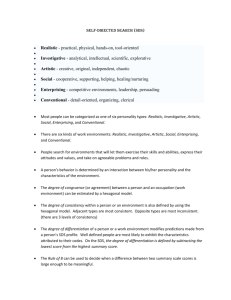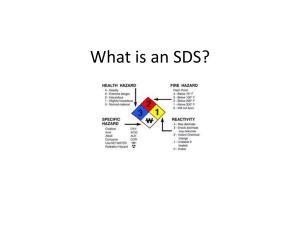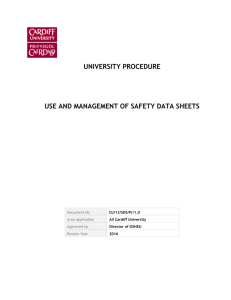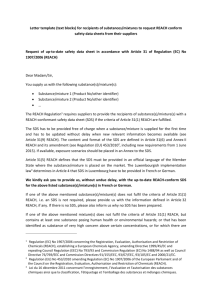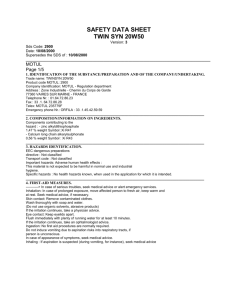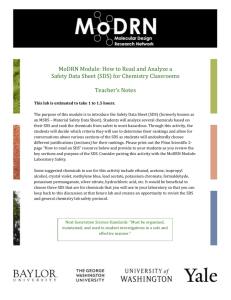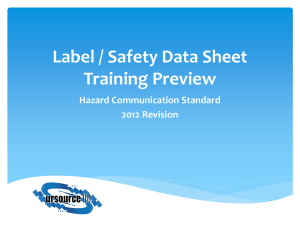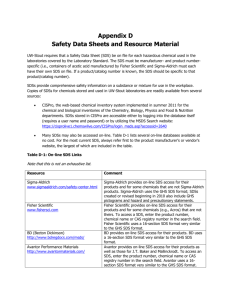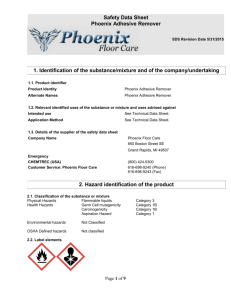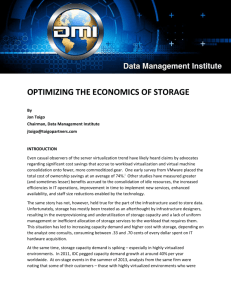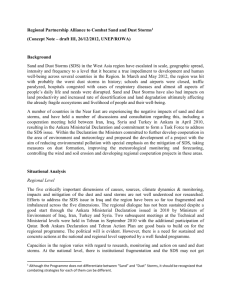completing the COSHH risk assessment form
advertisement
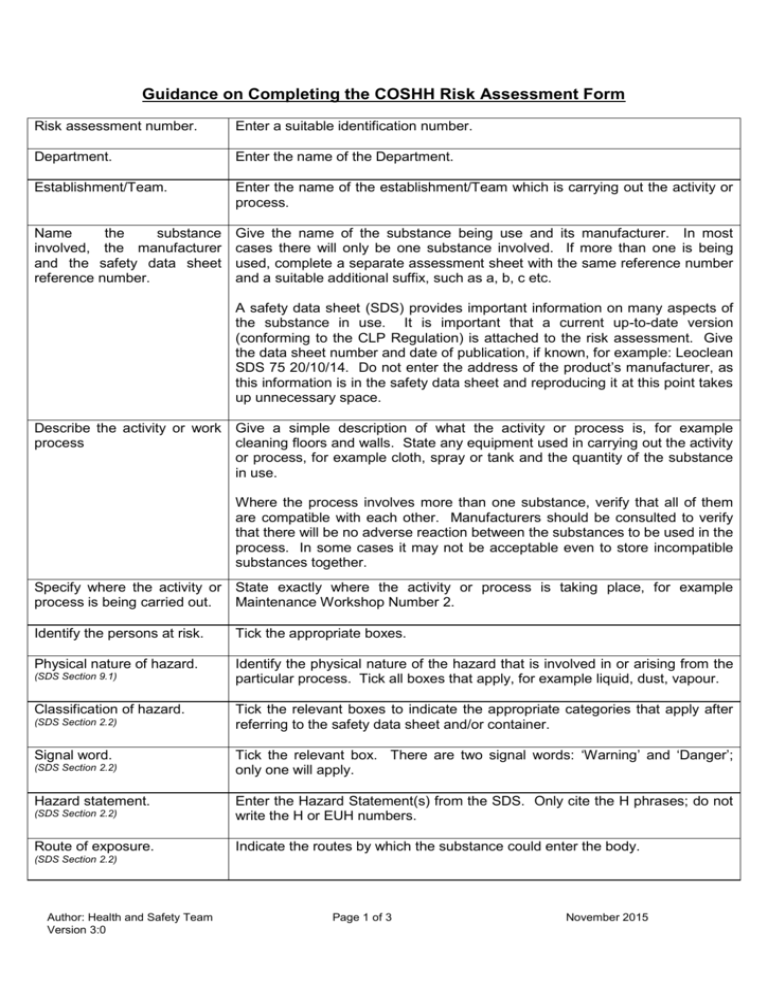
Guidance on Completing the COSHH Risk Assessment Form Risk assessment number. Enter a suitable identification number. Department. Enter the name of the Department. Establishment/Team. Enter the name of the establishment/Team which is carrying out the activity or process. Name the substance involved, the manufacturer and the safety data sheet reference number. Give the name of the substance being use and its manufacturer. In most cases there will only be one substance involved. If more than one is being used, complete a separate assessment sheet with the same reference number and a suitable additional suffix, such as a, b, c etc. A safety data sheet (SDS) provides important information on many aspects of the substance in use. It is important that a current up-to-date version (conforming to the CLP Regulation) is attached to the risk assessment. Give the data sheet number and date of publication, if known, for example: Leoclean SDS 75 20/10/14. Do not enter the address of the product’s manufacturer, as this information is in the safety data sheet and reproducing it at this point takes up unnecessary space. Describe the activity or work Give a simple description of what the activity or process is, for example process cleaning floors and walls. State any equipment used in carrying out the activity or process, for example cloth, spray or tank and the quantity of the substance in use. Where the process involves more than one substance, verify that all of them are compatible with each other. Manufacturers should be consulted to verify that there will be no adverse reaction between the substances to be used in the process. In some cases it may not be acceptable even to store incompatible substances together. Specify where the activity or State exactly where the activity or process is taking place, for example process is being carried out. Maintenance Workshop Number 2. Identify the persons at risk. Tick the appropriate boxes. Physical nature of hazard. Identify the physical nature of the hazard that is involved in or arising from the particular process. Tick all boxes that apply, for example liquid, dust, vapour. (SDS Section 9.1) Classification of hazard. (SDS Section 2.2) Signal word. (SDS Section 2.2) Hazard statement. Tick the relevant boxes to indicate the appropriate categories that apply after referring to the safety data sheet and/or container. Tick the relevant box. There are two signal words: ‘Warning’ and ‘Danger’; only one will apply. (SDS Section 2.2) Enter the Hazard Statement(s) from the SDS. Only cite the H phrases; do not write the H or EUH numbers. Route of exposure. Indicate the routes by which the substance could enter the body. (SDS Section 2.2) Author: Health and Safety Team Version 3:0 Page 1 of 3 November 2015 Risks to health – Most important symptoms and effects. (SDS Section 4.2) Pertinent information relating to the most important acute and chronic symptoms and effects experienced when engaged in the process/activity or arising from the use of the substance is usually given in the first aid section of the safety data sheet, under heading 4.2. Workplace Exposure Limits (WEL). (SDS Section 8.1) Check the manufacturer’s safety data sheet to see if the substance has been assigned a WEL. If it has, the long-term and short-term limits should be stated. In some instances workplace monitoring may be necessary. Control Measures. Identify all the controls required to reduce the risks associated with the use of the substance (other than personal protective equipment). The information is usually provided in section 8.2 of the SDS. Be very specific; if ventilation is required then the type should be documented, for example local exhaust ventilation with partial enclosure. If training is identified as a control then the level or standard of training required should be stated, for instance ‘Pesticides PA1’. Include special measures for vulnerable groups, such as disabled people and pregnant workers. Take account of those substances that are produced from activities undertaken by the employees of another employer. (SDS Section 8.2) Where a WEL has been assigned then the method for monitoring that the levels are not exceeded should also be stated, for example: personal monitoring. First aid – recommended actions. (SDS Section 4.1) State the emergency action that is to be taken. Other than the standard first aid box, stipulate what additional equipment will be needed, such as an eye irrigation tube. Is health surveillance or monitoring required? The use of specified substances or the undertaking of certain processes may require some employees to have their health monitored. This may take the form of simple observations made by a Supervisor, as is the case for monitoring dermatitis from using oil. Alternatively, it may require the Occupational Health Unit (OHU) to carry out more complex monitoring, such as lung function tests to check the effects of dust or fumes on the lungs. If there is any doubt over the requirements for health surveillance then the OHU should be contacted. Personal Protective Equipment (PPE). (SDS Section 8.2) Storage. (SDS Section 7.2) Disposal of residual waste and containers. (SDS Section 13.1) The SDS tends to be rather vague and generalised in respect of disposal. The guidance in the adjacent box is more detailed and specific). Author: Health and Safety Team Version 3:0 Any PPE required for use with a particular substance should be identified. Tick all appropriate boxes and then specify the type and standard of equipment to be used, for example eye protection - goggles to BS EN 166 - 349B. Indicate how and where the substance is stored. suitable storage area for used cylinders. Ensure that there is a Detail how waste substance is to be disposed of and remember to consider the containers as well, as these may contain hazardous residues. Ensure that risks to the environment are considered. Any residual product or heavily contaminated containers must be classed as hazardous waste. The waste will be categorised as flammable, corrosive, toxic etc. and, therefore, a specialist waste contractor must be used to dispose of it and a consignment note must be completed. Further advice should be sought from a waste disposal company or the County Council’s Waste Management Team on 0345 600 6400. Page 2 of 3 November 2015 Gas cylinders should usually be returned to the supplier for re-use. Ensure that this arrangement is in place when purchasing gas. Sometimes it is appropriate to return empty containers, such as 205 litre oil drums to the supplier. If such an arrangement is in place, these should be returned to the depot to await collection. Other empty containers, for example, detergent bottles and clean cardboard boxes can be placed into the appropriate recycling bin for the specific type of waste, such as plastic, metal or cardboard. As a last resort, where no recycling facility is available, empty containers (free from any residual product) can be disposed of via the general waste skip or bin. Is exposure adequately controlled? Local waste disposal procedures and instructions should be consulted. Tick the appropriate box. Risk rating following the Having implemented the appropriate control measures, apply the risk rating to implementation of control indicate whether the risks are low, medium or high. measures. Assessed by and date. Enter the date when the assessment was carried out. Sign and date the risk assessment. Please ensure that the signature is legible. Review date. Enter the date when a re-assessment should be undertaken. This will normally be one year after the first assessment. However, high-risk processes may need to be re-assessed more often. In addition, if any of the elements of the process/activity alter then the re-assessment should be carried out immediately. Author: Health and Safety Team Version 3:0 Page 3 of 3 November 2015


